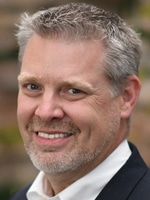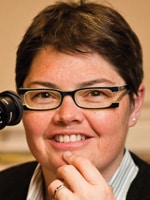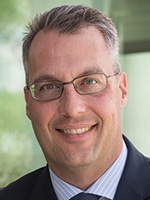December 2023—Digital pathology and AI—the push, the potential, the changing questions, the reimbursement, and the caution. All that and more came up when CAP TODAY publisher Bob McGonnagle on Oct. 17 led a conversation online with pathologists and industry representatives.
M. E. (Doc) de Baca, MD, told the group that what makes pathologists unique is the wisdom derived from knowledge. “Our results are given with perspective and in context; they then lead to correct actions. I do not believe that in my lifetime, in the arena of wisdom, human physicians will be conquered by machines.” The value of augmented intelligence, she added, “is proportional to the wisdom only we can provide.”
More from Dr. de Baca and the others follows.
Katie Gillette, the report your consulting company released in May provided an overview of the digital pathology market from 2023 to 2028 and was the inspiration for CAP TODAY’s October cover story (“Digital path’s star rises from the mists”). My perception, after reading the report and other coverage, is while we’re still in low digits in terms of using digital pathology for surgical pathology primary diagnosis, the slope seems to be going almost straight up. I’m hearing more and more about people implementing it. What’s your impression about where the field stands today?

Gillette
Katie Gillette, senior project leader, DeciBio Consulting: It’s hard to have a clear definition of what digital pathology adoption looks like within an institution. In many institutions, digital pathology might be having one scanner sitting in a corner. In very few institutions, every slide is scanned and the workflows are fully digitized. We’re seeing changes in both of those groups. Some who are nonadopters and don’t have any of these tools are now becoming more familiar with the companies and technologies and thinking about how their practices could adopt them. Some groups that have the scanner in the corner are starting to think, Can I use this to support tumor boards? Can I use it to look at the harder cases? The transition from that to a fully digitized workflow is hard and requires champions across the lab and institution, but the right conversations are being had.
Leading academic medical centers and comprehensive cancer centers are increasingly interested in offering best-in-class pathology tools, including digital pathology hardware and the algorithms, and being involved in the development of those tools. We’re continuing to hear excitement from oncologists and it’s been great to see that increasing over the past six months.
Mike Quick, as the incoming president of the Digital Pathology Association, tell us what your impression is about the rate of adoption now.

Quick
Michael Quick, president-elect, Digital Pathology Association, and vice president, research and development and innovation, Hologic: Perceptions about how quickly digital pathology is being adopted can vary widely. For example, if you were to attend the upcoming Pathology Visions meeting and talk with members of the DPA, you could conclude that digital pathology and the use of AI is largely fully adopted. There are a lot of champions who are moving the field forward, excited about the technology, and transitioning that into clinical practice. However, attending more general pathology meetings you might see that it’s still early days. We are exploring ways to harness and extend the excitement and enthusiasm evident at Pathology Visions and in the DPA community more broadly.
I have been working on the membership committee of the DPA for the past several years, and the association has grown tremendously—we recently surpassed 4,000 members, and attendance at Pathology Visions is expected to be the largest yet. This level of involvement is outstanding and reflects the growing interest in the field.
Eric Glassy, what’s your perspective on the rate of adoption? I note, in passing, that Alverno has gone with a completely digital workflow. Also, Keith Kaplan, one of the longtime leaders in the field, wrote a few brief notes on the first 100 days of using digital pathology for primary diagnosis (tissuepathology.com).
Eric Glassy, MD, medical director, Affiliated Pathologists Medical Group, Rancho Dominguez, Calif.: The drivers have shifted. Initially pathologists were pushing it, saying they need it for tumor board, education, research. Remote sign-out was a big boost that helped people understand the value of digital pathology. Slow adopters thought, This isn’t as bad as I thought it would be; I can modify my workflow to accommodate it. Many of us thought AI would push it, and that’s helped a bit.
The push now is the shortage of pathologists. Providence health system in California, Alaska, Montana, New Mexico, Oregon, and Washington has a number of smaller hospitals and there are not enough pathologists for the workload. So the next wave of adoption, or at least interest on the part of those who write the checks, is around the shortage of pathologists and trying to fill those needs, particularly in rural hospitals.
Doc de Baca, the early years of digital pathology were plagued by concerns around FDA regulation, but pathologist anxiety was also a drag on the field. There was concern about pathologists losing their jobs to digital pathology, with visions of digital pathology enabling a handful of centers or even pathologists to take a dominant amount of the work. That anxiety seems to be going away. Do you agree with that? And can you talk about the latest anxiety—that AI is now the big threat to job security?

Dr. de Baca
M. E. (Doc) de Baca, MD, vice president for medical affairs, Sysmex America; founder of MDPath; and hematopathologist, Pacific Pathology Partners, Seattle: With the entry of digital pathology we were concerned about regulations and pathologists losing jobs; now with AI, here we are, talking about regulations and pathologists losing jobs. If we had a Gaussian curve of technology implementations, our buckets would be: one, the “bleeding edge” group—the early adopters of technologies; two, the “kind of early” adopters; three, the “we have to get on this train because it’s already out of the station” folks; and finally, four, the “never going to join”-ers. Take that Gaussian curve and think about where it was 20 years ago. Now shift it further left, because the people we call Luddites today would have been on the bleeding edge then—they have more computing power in their cell phones than took us to the moon. Current society is extremely amenable to the idea of technology permeating our lives, resulting in a significant reduction in the activation energy needed to bring highly sophisticated digital or computational solutions into every space of medicine.
People have to make decisions about spending money, that’s a big deal, but it is currently offset by the insufficient numbers of people in our workforce. Additionally, the ONC [Office of the National Coordinator for Health Information Technology] and FDA are asking for data; they want information for pre- and post-market surveillance of instruments, drugs, and diagnostic tests. It’s become clearer that with data interoperability—if we could share our data—our patients would be better for it. While pathologists continue to fret about jobs, they’re starting to notice that adapting to the new technologies makes them more, rather than less, appealing in the market.
We still have regulations to think about. Pathology has the CLIA environment that people in other specialties don’t have to deal with. My anxiety is that pathologists aren’t blowing our own horns loudly enough: We’re the physicians who understand how tests and data work and how they work together. We can see where data are adequate or inadequate in a way other specialties are not as well equipped to do. If people start using our data for algorithms without involving us, their algorithms have the potential to be less safe than they would if we were invited to or forceful about being included in those conversations. I’m hesitant to say I’m pro-regulation, but I support doing everything we can to ensure our patients’ safety, even if it means added CLIA-like regulations for AI models originating outside the lab.
Dr. Glassy (Affiliated Pathologists): Pathology is a job, an occupation, but it’s made up of a bunch of smaller tasks. AI is very good at the small tasks but terrible at jobs. It doesn’t have a way of putting it all together like the pathologist needs to do. So if your job is to find acid-fast bacteria, you are going to be out of a job. If your job is to diagnose a lymph node with a constellation of features that are critical to the patient’s treatment, you are not out of a job. I look forward to AI making those repetitive tasks easier, helping with business management and QA and QC, finding mitoses, et cetera, but I don’t see a threat for the job itself.
Mike Quick, talk about how Pap test screening affected the job market for cytopathologists and cytotechnologists. We know technologies like this disrupt and change the standard patterns of employment. Give us a little history and then project how that history might replay itself, or not, in the field of digital pathology for surgical pathology.
Michael Quick (president-elect, DPA): We’ve seen ups and downs in the cytology workforce and it’s been significantly impacted by changes in guidelines. Technology has come alongside and supported the wave of those transitions and been the driver behind where these tools help laboratories offer the work in a way they hadn’t previously. With each new technology there can always be fear that it will replace jobs, but that’s not been the case in cytology. There’s currently a significant shortage relative to the need for trained cytologists as well as pathologists. The roles of the cytologist and pathologist in the laboratory are evolving. It’s not just looking through a microscope and doing the same repetitive task. The amount of information practitioners have to take in, the combinations of additional IHC stains, molecular testing, genetic profiles—much more data is being used to make a diagnosis. The only way that will be possible is to bring in tools that make the more repetitive tasks easier to do.
In our November issue is a roundtable on artificial intelligence. In the discussion, Ajit Singh of Artiman and Stanford made an important point that no AI can work unless the greatest experts in the field to which it’s applied are in the trenches working with the algorithms and the machine learning. He did that to suggest there’s a pairing of expertise with machine learning that is indissoluble. Mike Rivers, can you comment on that?

Rivers
Michael Rivers, vice president and lifecycle leader of digital pathology, Roche Tissue Diagnostics: We’ve been talking about pathologists and AI as if it’s a conflicting relationship, but it’s a complementary, mutually beneficial one. AI is only as good as the ground truth it’s given, and that comes from the pathologists, from the stains that are prepared, et cetera. The AI tools contemplated now will bring new insights to pathologists to aid in the diagnosis and treatment path for that patient and will impact our lives in an exciting way.
We still need a pathologist who’s taken the Hippocratic oath and has the judgment to drive the diagnostic decision for the patient. But we are going to see more and more of these tools come into practice. It’s still more about potential than reality; there are very few available for clinical use, but that will change dramatically in the next several years, and those who embrace it will do extremely well.
Lisa-Jean Clifford, what are your thoughts on digital pathology adoption?
Lisa-Jean Clifford, chief operating officer and chief strategy officer, Gestalt Diagnostics: Using the technology as we have, coming out of the pandemic, to work virtually and have roundtables in settings such as this, has helped with adoption and access to different types of technologies as well as with the comfort with and acclimation to them. We have clients who are using digital platforms to onboard new pathologists and to manage their credentials. There are ways to think outside the box in how the technologies can be applied to benefit an organization.
 CAP TODAY Pathology/Laboratory Medicine/Laboratory Management
CAP TODAY Pathology/Laboratory Medicine/Laboratory Management
